Scottish Sea Fisheries Statistics 2021
National Statistics publication that provides data on weight and value of sea fish and shellfish landed by fishing vessels, structure of the Scottish fishing fleet and employment on Scottish vessels. The supporting documents include accessible tables and a pdf version of the publication.
This document is part of a collection
2 Landings by Scottish vessels
In 2021, Scottish vessels landed 437 thousand tonnes of sea fish and shellfish with a gross value of £560 million (Table 8). Compared to 2020 there was an increase of 15 per cent in the real value of landings and a 10 per cent increase in the tonnage landed.
The increase in real value was driven by shellfish and pelagic species, as demersal species decreased in value.
Shellfish landed by Scottish vessels and included in this publication are crustaceans, molluscs and cephalopods. This includes species such lobsters and crabs, which are commonly eaten in restaurants. Therefore, hospitality closures due to Covid-19 resulting in a loss of trade and markets particularly affected the shellfish sector in 2020. Markets at home and abroad collapsed as a result of hospitality closures. Despite positive signs, recovery is still ongoing as some restrictions were still in place in 2021, particularly in the hospitality sector.
The closure of the restaurant and hospitality sector in the UK and abroad during periods of 2020 and 2021 also impacted the demersal sector. Demersal fish are those which live close to the seabed such as cod, haddock and monkfish. Reduction of quota allocation to Scotland for species such as cod has also negatively impacted the demersal sector.
The pelagic sector are species found mainly in shoals in midwater or near the surface of the sea such as herring and mackerel. This sector is seasonal and generally operates with larger vessels. It was largely unaffected by the impacts of Covid-19 and increased in tonnage and value in 2020 and again in 2021.
Scotland’s commercial fishing industry comprises a significant proportion of the United Kingdom fishing industry. Landings by Scottish vessels accounted for 61 per cent of the value and 67 per cent of the tonnage of all landings by UK vessels in 2021 (Table 25a).
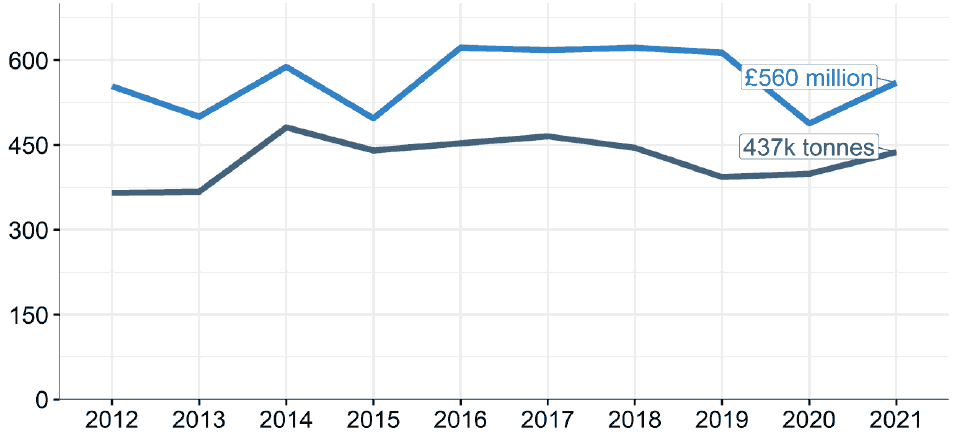
Data source: Table 3.
As can be seen in Chart 1, the long term trend for the value of the fish landed by Scottish vessels has been generally stable since 2016, with 2020 being an exception due to the impacts of Covid-19.
2.1 Key species landed
The 15 per cent increase in the real terms value of landings by Scottish vessels, to £560 million between 2020 and 2021, was driven by an increase in the value of shellfish and pelagic species. The real terms value of shellfish landings increased by 29 per cent and pelagic landings increased by 18 per cent compared to 2020, whereas demersal landings decreased by one per cent.
The 10 per cent increase in tonnage landed by Scottish vessels is attributed to an increase in landings of shellfish and pelagic fish. Shellfish landings rose 18 per cent by tonnage and pelagic landings rose 14 per cent. Demersal landings decreased by 10 per cent.
| Species | Tonnage 2021 | Tonnage change from 2020 (percent) | Value 2021 (thousands of pounds) | Value change from 2020 (percent) |
|---|---|---|---|---|
| Haddock | 20,231 | -14 | 28,967 | -11 |
| Monkfish | 12,612 | 10 | 33,747 | 12 |
| Cod | 5,838 | -31 | 20,021 | -17 |
| Whiting | 10,306 | 2 | 14,058 | 11 |
| Other demersal | 28,934 | -12 | 50,655 | 3 |
| Total demersal | 77,920 | -10 | 147,447 | -1 |
| Mackerel | 185,140 | 8 | 209,979 | 16 |
| Herring | 51,438 | 5 | 32,711 | 20 |
| Other pelagic | 65,745 | 46 | 14,970 | 39 |
| Total pelagic | 302,324 | 14 | 257,659 | 18 |
| Nephrops | 22,505 | 41 | 70,488 | 50 |
| Scallops | 17,432 | 20 | 29,801 | 10 |
| Edible crabs | 8,275 | 2 | 18,441 | 26 |
| Lobsters | 1,168 | 8 | 17,721 | 25 |
| Other shellfish | 7,580 | -10 | 18,804 | 5 |
| Total shellfish | 56,960 | 18 | 155,255 | 29 |
| Total | 437,203 | 10 | 560,362 | 15 |
Mackerel remained the most valuable species with £210 million landed, accounting for 37 per cent of the total value of Scottish landings. In 2021, the real value of mackerel landings increased by 16 per cent and tonnage increased by eight per cent. This increase is in line with an increase in available quota. Quota is the share of the fish catch allowed to vessels. Scottish vessels’ landings accounted for just over four fifths (82 per cent) of UK mackerel landings by tonnage and 86 per cent by value.
Scottish vessels commonly catch a wide variety of demersal species, including more than a dozen species with landings that are worth £1 million or more annually (Table 8). Monkfish became the most valuable demersal species and represented six per cent of the total value of Scottish vessels’ landings and 23 per cent of the value of demersal landings in 2021.
Nephrops are the most valuable shellfish stock and the only shellfish species currently subject to quota. Scottish vessels fish for Nephrops by creeling and by trawling. Creeled Nephrops are often caught and exported live. Creeled Nephrops represent a smaller tonnage of landings, but attract an average price per tonne four times that of trawled Nephrops. Some trawled Nephrops are sold whole but the majority are sold as tails for turning into scampi. In 2021, 1,423 tonnes of creeled Nephrops were landed by Scottish vessels with a value of £15 million[6]. Twenty-one thousand tonnes of trawled Nephrops were landed worth £55 million. These data are presented in Table 30c.
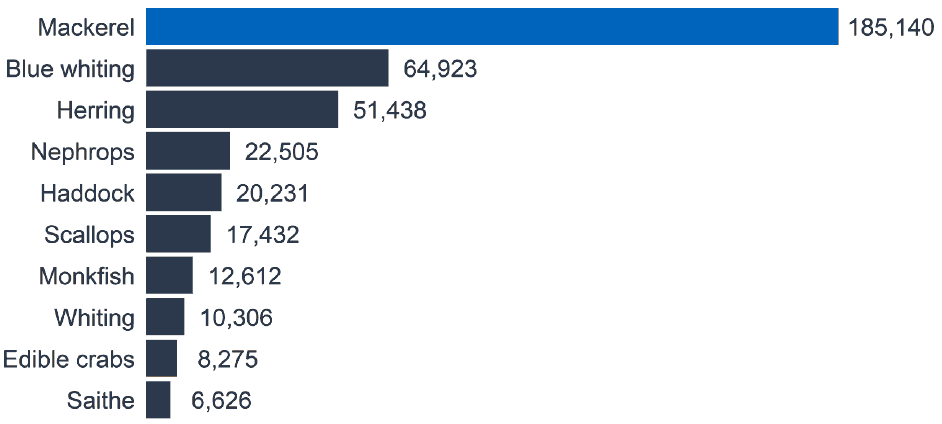
Data source: Table 8.
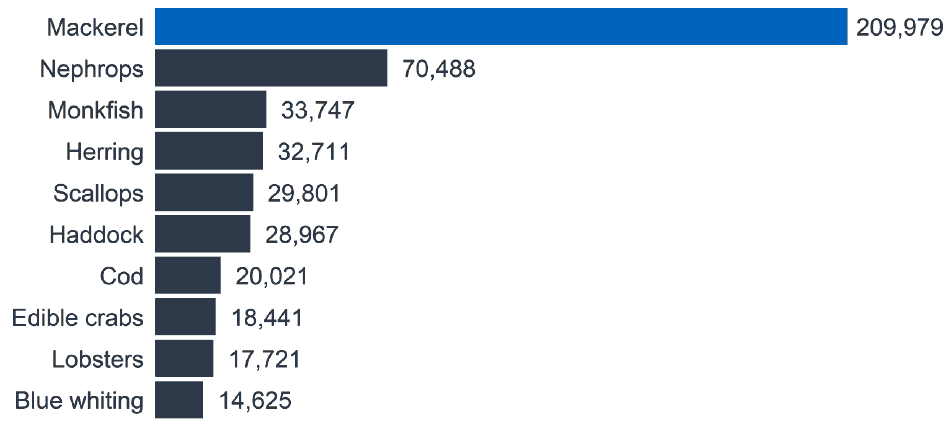
Data source: Table 8.
Long term sector trends
Over the past ten years 2012-2021, the tonnage of pelagic landings has increased by 51 per cent with real terms value increasing by 31 per cent.
Compared to 2012, the tonnage of demersal landings fell by 19 per cent with real terms value decreasing by 13 per cent. Over the period 2012 to 2021, shellfish landings and real terms value have both fallen by 17 per cent. The decreases for shellfish and demersal are unlikely to be a long-term decrease and more a reflection of the decrease in 2020 and 2021 (compared to 2019) due to the impact of Covid-19.
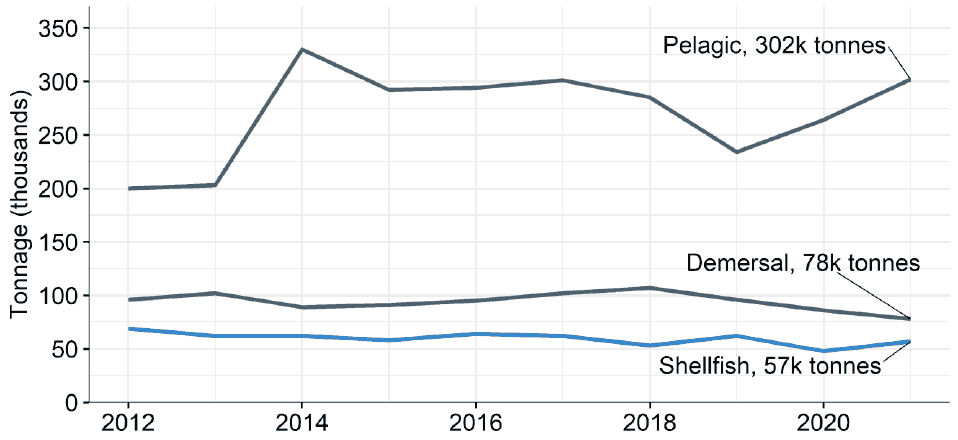
Data source: Table 3.
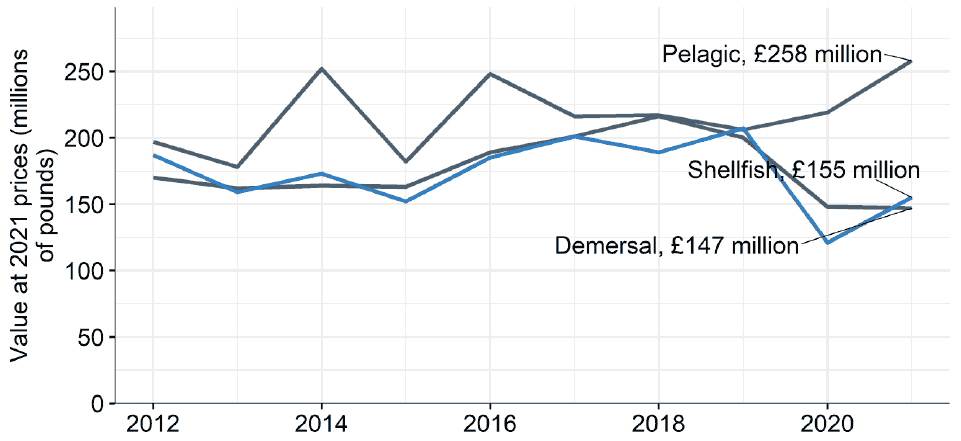
Data source: Table 3.
Fish prices
Scottish vessels land a vast range of different species throughout the year and they all achieve different prices at auction. The price achieved will vary by species, individual market, supply, demand, seasonality and the condition of the fish. Table 2 shows the average price per tonne for a selection of species landed by Scottish vessels.
| Species | Price per tonne 2021 (pounds) | Price per tonne 2020 at 2021 prices (pounds) | Price per tonne change from 2020 (percent) |
|---|---|---|---|
| Mackerel | 1,134 | 1,060 | 7 |
| Nephrops | 3,132 | 2,942 | 6 |
| Monkfish | 2,676 | 2,623 | 2 |
| Herring | 636 | 557 | 14 |
| Scallops | 1,710 | 1,866 | -8 |
| Haddock | 1,432 | 1,390 | 3 |
| Cod | 3,429 | 2,865 | 20 |
| Edible crabs | 2,229 | 1,797 | 24 |
| Lobsters | 15,171 | 13,045 | 16 |
| Blue whiting | 225 | 231 | -2 |
It is clear that there is great variation in the prices achieved across the different species. Mackerel is the highest value species for Scottish vessels yet has a much lower price per tonne than many other species. It is the vast tonnage of mackerel caught that leads to the value being so high.
Lobsters have the highest price per tonne yet a fairly low value compared to other main species. This is due to seasonality, lobster is not in season during several months of the year resulting in a lower tonnage landed throughout the year compared to other species. They are also considered a luxury food and tend to be purchased mainly by the hospitality sector.
Total Allowable Catches quota and uptake
Total Allowable Catches (TAC) are limits set at annual international negotiations for individual fish stocks and represent the maximum of each fish stock that can be caught. Up until 2020, while the UK was still a member of the European Union (EU) the majority of stocks were managed and fished only by EU member states. Member states access to management and fishing of stocks were based on a number of factors, including historic track record. The TACs for these stocks were set by the European Commission through internal negotiations between EU member states with an interest and based on independent scientific advice from ICES. The remaining stocks were managed and shared with other Coastal States: Norway, Iceland, the Faroe Islands, Greenland and Russia, with TACs for these set at separate negotiations. The amounts corresponding to this share, known as quotas, are shown at the UK and at the Scottish Producers Organisations’ (POs) level in tables 36a to 36d.
Uptake of key commercial quota stocks by all Scottish vessels by tonnage and value landed are presented in table 37. In general, Scottish POs had high quota uptake in 2021 for key demersal and pelagic species. Uptake of mackerel stocks in the North Sea was above 90 per cent and uptake of mackerel stocks in the West of Scotland exceeded quota[10].
For demersal stocks, uptake in the North Sea was generally high with cod quota uptake at 99 per cent and monkfish at 91 per cent. West of Scotland cod has a nil quota and is managed as a bycatch. The Scottish quota reduction for cod of more than 66 per cent between 2019 and 2021 led to an increased pace of quota uptake, reflecting the importance of this species to the domestic fleet.
The only shellfish species subject to quota is Nephrops. In 2021, Scottish PO quota uptake for North Sea Nephrops was 91 per cent and for West Coast Nephrops it was 65 per cent. This is 30 percentage points up compared to 2020 for the North Sea and 21 percentage points up for the West Coast.
2.2 Where Scottish vessels land their fish
Scottish vessels land their catches into Scotland, the rest of the UK and several countries abroad. In 2021, Scottish vessels landed 170 thousand tonnes of sea fish and shellfish worth £148 million abroad.
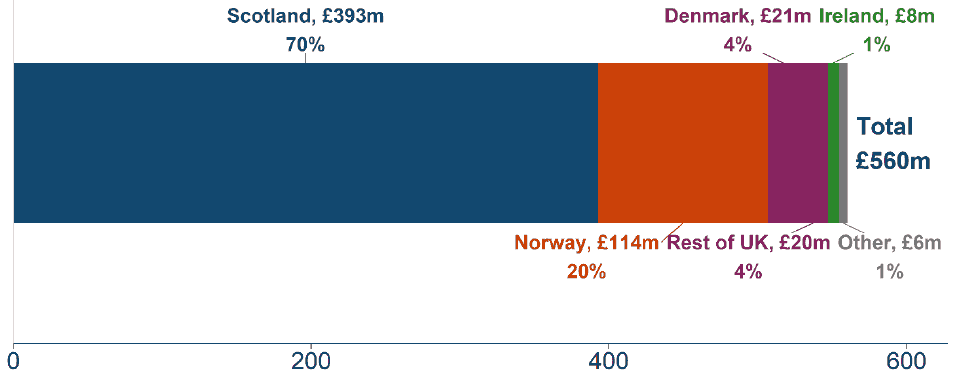
Data source: Table 4, Table 5, Table 8, Table 28.
Landings abroad accounted for 39 per cent of all landings by Scottish vessels by tonnage and 26 per cent by value. Of this, 93 per cent of the tonnage landed abroad was pelagic.
The main species landed abroad was mackerel, representing 77 per cent of the total value of fish landed abroad in 2021. There were 100 thousand tonnes of mackerel worth £114 million landed abroad, which is both 54 per cent of the total tonnage and value of mackerel landed by Scottish vessels.
Norway is by far the largest destination for Scottish vessels’ landings abroad, accounting for 20 per cent by value of all Scottish vessels’ landings and 77 per cent by value of all landings abroad. In 2021, 89 per cent of the value of landings into Norway was for mackerel, amounting to 89 thousand tonnes with a value of £101 million.
Area of capture
Scottish vessels are most active in two main ICES Rectangles[11] : the Northern North Sea (ICES Area IVa) and the West Coast of Scotland (ICES Area VIa).
In 2021, 212 thousand tonnes of sea fish and shellfish with a value of £306 million were landed from the Northern North Sea (IVa), representing 48 per cent of the tonnage and 55 per cent of the value of all landings by Scottish vessels (Table 31).
Over one third (34 per cent) of landings by Scottish vessels, by tonnage were caught in the West Coast of Scotland (VIa), providing 31 per cent of the total value of all Scottish landings.
Area VII accounted for nine per cent of the tonnage of all landings and five per cent of value.
Contact
There is a problem
Thanks for your feedback